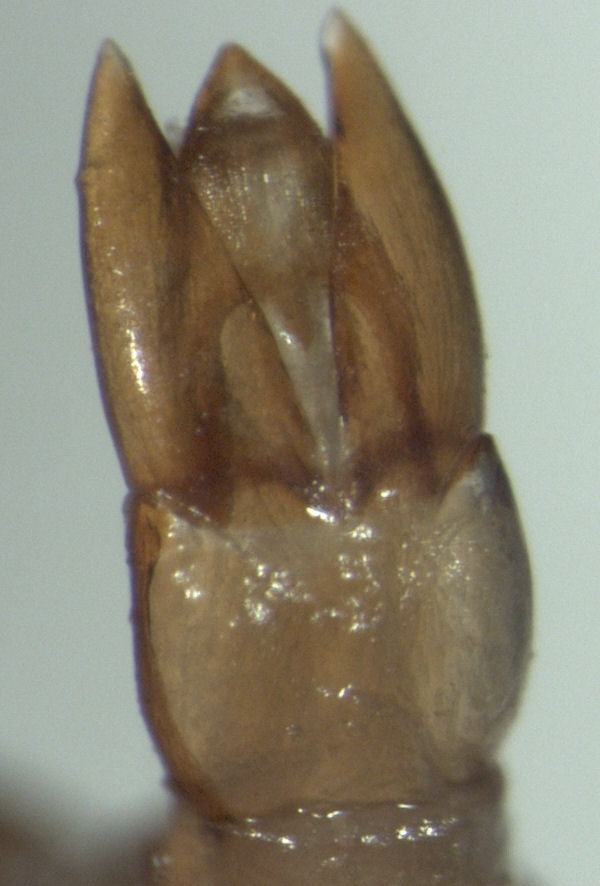aedeagus on:
[Wikipedia]
[Google]
[Amazon]

 An aedeagus (plural aedeagi) is a reproductive organ of male
An aedeagus (plural aedeagi) is a reproductive organ of male

 An aedeagus (plural aedeagi) is a reproductive organ of male
An aedeagus (plural aedeagi) is a reproductive organ of male arthropod
Arthropods (, (gen. ποδός)) are invertebrate animals with an exoskeleton, a Segmentation (biology), segmented body, and paired jointed appendages. Arthropods form the phylum Arthropoda. They are distinguished by their jointed limbs and Arth ...
s through which they secrete sperm from the testes during copulation with a female. It can be thought of as the insect equivalent of a mammal's penis
A penis (plural ''penises'' or ''penes'' () is the primary sexual organ that male animals use to inseminate females (or hermaphrodites) during copulation. Such organs occur in many animals, both vertebrate and invertebrate, but males do no ...
, though the comparison is fairly loose given the greater complexity of insect reproduction. The term is derived from Ancient Greek
Ancient Greek includes the forms of the Greek language used in ancient Greece and the ancient world from around 1500 BC to 300 BC. It is often roughly divided into the following periods: Mycenaean Greek (), Dark Ages (), the Archaic p ...
αἰδοῖα (''aidoia'', "private parts") and ἀγός (''agos'', "leader"). It is pronounced or .
The aedeagus is part of the male's abdomen
The abdomen (colloquially called the belly, tummy, midriff, tucky or stomach) is the part of the body between the thorax (chest) and pelvis, in humans and in other vertebrates. The abdomen is the front part of the abdominal segment of the tors ...
, which is the hindmost of the three major body sections of an insect. The pair of testes of the insect are connected to the aedeagus through the genital ducts. The aedeagus is part of the male insect's phallus, a complex and often species-specific arrangement of more or less sclerotized (hardened) flaps and hooks which also includes in some species the valvae (clasper), which are paired organs which help the male hold on to the female during copulation. During copulation, the aedeagus connects with the ovipore
An ovipore is a pore-like sexual organ of a female insect that is inseminated by the spermatophores ejected by the aedeagus of a male insect during copulation. The spermatophores that pass through the ovipore are stored in most insect species in ...
of a female. The aedeagus can be quite pronounced or ''de minimis''.
The base of the aedeagus may be the partially sclerotized phallotheca, also called the
phallosoma or theca. In some species the phallotheca contains a space, called the endosoma (internal holding pouch), into which the tip end of the aedeagus may be withdrawn (retracted). The vas deferens is sometimes drawn into (folded into) the phallotheca together with a seminal vesicle.
The sperm of arthropod
Arthropods (, (gen. ποδός)) are invertebrate animals with an exoskeleton, a Segmentation (biology), segmented body, and paired jointed appendages. Arthropods form the phylum Arthropoda. They are distinguished by their jointed limbs and Arth ...
s is not passed to the female as liquid with free-swimming spermatozoa
A spermatozoon (; also spelled spermatozoön; ; ) is a motile sperm cell (biology), cell, or moving form of the ploidy, haploid cell (biology), cell that is the male gamete. A spermatozoon Fertilization, joins an ovum to form a zygote. (A zygote ...
, but as capsules called spermatophores in which the actual spermatozoa are enclosed. In addition to the spermatophores, in some species
In biology, a species is the basic unit of Taxonomy (biology), classification and a taxonomic rank of an organism, as well as a unit of biodiversity. A species is often defined as the largest group of organisms in which any two individuals of ...
the aedeagus also discharges a spermatophylax, a ball of nutritious secretions, as a nuptial gift to aid the female in producing offspring.
In males of most species of Lepidoptera, the aedeagus has a sheath which is supported by an organ called the juxta, which is located between the aforementioned valvae.
See also
* Pedipalp#Spider pedipalps for spermatophore transfer in arachnidsReferences
{{reflist Animal reproductive system Sex organs Insect anatomy